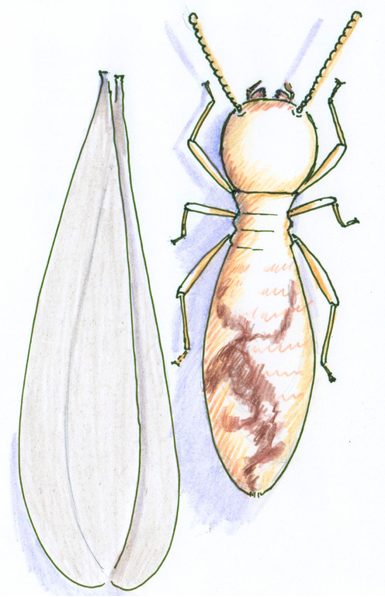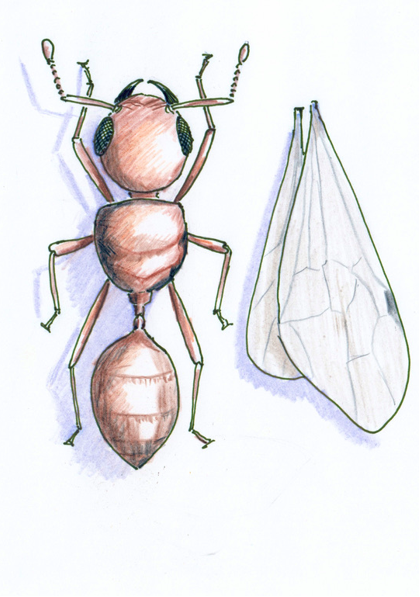Identifying Australian Flying Termites From Ants
It’s very simple; you don’t even need a magnifying glass when doing your termite inspection. Flying termites are the only insect that has all four wings of the same size and shape. And these winged white ants drop them soon after they’ve landed.

Termite Worker

Ant Worker
If you see a lot of wings on the back porch and they are all the same size… you know that termites flew last evening.
There is a nest nearby, defending your home against termites from that nest is your next job!
But What if the Termites Flew From the Inside of Your House?
It sometimes happens if your home is already under termite attack without you knowing. That can be terrifying to find a termite infestation.
Winged termites instinctively choose to launch their nuptial flights from the highest points of their gallery system. In the natural world, the launch is from a high branch or trunk of a tree they are eating. If they are eating a post; same thing. If they are eating a building, they can cut out a launching slot up high and wait for the required warm, humid evening. Smart ones choose to make their launch slots on the outside, say the gable, eaves, pergola, etc., where they can launch and flutter weakly to the ground a few hundred metres away. Sometimes the launch slot is located inside: the exposed ceiling beams, timber panelling, etc., and when one of the soldiers guarding the slot yells “Geronimo!” they all pour out into the living areas and only get as far as the floor.
Of course, as explained, they may have access to wood such as skirting boards but there is no constant source of water and no soil to turn into mud to build a protective cave. And there is nowhere to hide from you squirting fly-spray in their direction either.
If this is your predicament, you should carefully inspect inside for hollowed-out timbers where they have been busy. Do not tear timbers apart, you need to keep them busy, undisturbed and feeding so that you can add pouches of Colony Killer Termite Treatment which they take back to kill off the queen and the whole nest (wherever it is).
Australian Termites Fly-in Warm Weather, Usually on Humid Evenings
Just because you see perhaps hundreds of flying termites around your veranda windows, on the patio or even those that have crawled inside under the door, it does not mean your home is about to be devoured.
These ‘teenager’ termites need three factors to start a nest.
They need all three:
- food (wood)
- a constant source of moisture
- security (a damp ‘cave’ which the pair can build with mud).
They seldom find those requirements inside a house.
There’s plenty of wood but no constant moisture adjacent to that wood and no mud to build protection against ants and to retain humidity. That’s why there are almost never any nests begun and maintained inside houses. Just occasionally it happens where guttering doesn’t drain due to decaying leaf blockage… but then there is a dry spell without rain and the flying termites or white ants cannot retain the necessary humidity inside the nest where the new nymphs depend on it. If so, it dies.
In fact, over 90% of flying termites never get a nest started, even in bushland. There may be plenty of wood from fallen branches and the soil may be moist from summer rains… but if it then dries up, without moisture, it fails. Just as well, or we’d be overrun with white ant attack.
Having Termite Monitors around your home helps you see when termites have arrived, much better than finding termite wings. If you need to kill termites quickly and stop the damage, you need Termikill.
Additional Flying Termites Information
You can download our free How-to-Guide
Check out the rest of our website and shop
OR speak to a friendly, helpful human… 1800 20 30 20
OR click here to open a chat
Questions & Answers
What factors do flying termites need in order to start a nest and cause damage?
Three things; Food (wood), moisture, and a safe place to live.
What’s the difference between a termite and a flying ant?
Termites are the only insect that has all four wings of the same size and shape. And they drop them soon after they’ve landed.
What is the best way to kill flying termites?
A pouch of Colony Killer Termite Bait is what will help you take care of these nasties.

